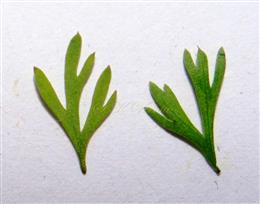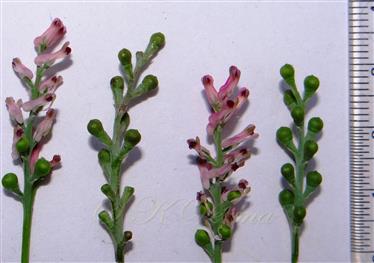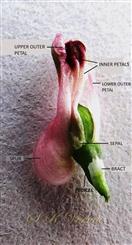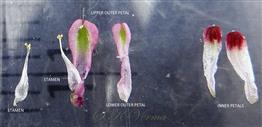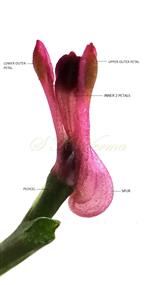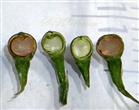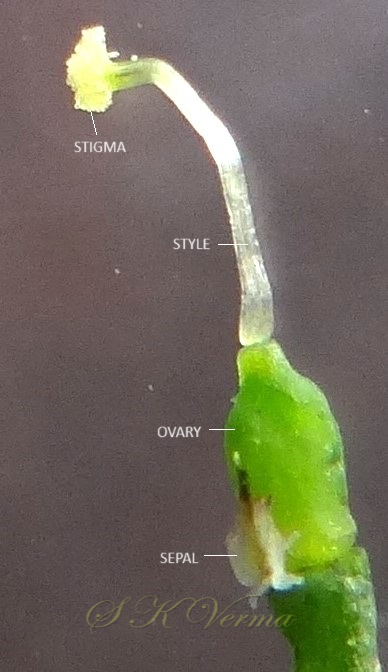FUMARIA
Fumaria Tourn. ex. L., Sp. Pl. ed.1: 699. 1753; Gen. Pl. 5: 314. 1754; 1867; Boiss., Fl. Or. 1: 132; 1867; Hook. f. & Thoms., Fl. Ind. 1: 138. 1855; Hook. f., Fl. Brit. India 1: 127. 1875; Pugsley, J. Linn. Soc. Bot. 44: 250. 1919; Zhang & Liden, Fl. China @ eFloras.org 7: 428; Boufford, Fl. North Amer. @ eFloras.org vol. 3; Fl. Pak. @eFloras.org p. 38.
Annual, often scandent herb, glabrous or subglabrous, glaucous. Stems angular, leafy and branched throughout. Leaves alternate, irregularly 2-4-pinnatisect with many narrow segments, petiolate, subsessile or sessile. Inflorescence generally leaf-opposed, racemose, subspicate. Bracts often short, linear oblong, as long as or slightly longer than pedicel. Flowers short, zygomorphic, white, pink or purplish. Sepals 2, short, petaloid, dentate. Petals 4, in 2 whorls, only the upper outer petal with short saccate spur, spur much shorter than lamina, inner 2 petals smaller and narrower than the outer ones and fused at apex. Stamens 2 (apparently 6 in 2 bundles), tripartite, the central branch bearing a bithecous anther, the lateral branches bearing monothecous anthers. Ovary 1-locular, usually suborbicular with 1(-2) ovules on each placenta; style short, often filiform; stigma entire to somewhat lobed. Fruit +/- globular nut, with 2 small depressions at apex. Seed usually large, suborbicular, brownish.
53 species
Fumaria indica
Fumaria indica (Hausskn.) Pugsley, J. Linn. Soc. Bot. 44: 313. 1919; Raghavan et al., Rec. Bot. Surv. India 21(2): 5. 1981; Sharma & Kachroo, Fl. Jammu (Illustr.) 2: t. 8. 1983; Singh & Sharma, Fl. Chamba Dist. 153. 2006; Blatter et al., J. Bomb. Nat. Hist. Soc. 34(3): 6676. 1933; F. parviflora var. indica (Hausskn.) Parsa, Fl. Iran 2: 490. 1986; F. vaillantii var. indica Hausskn., Flora 56: 443. 1873; F. parviflora subsp. vaillantii (Lois.) Hook.f. & Thoms., Fl. Ind. 1: 238. 1955; Hook. f., Fl. Brit. Ind. 1:128. 1875.
Annual herb, erect, scandent, 5-40 cm long; stem delicate, much branched, glaucous, somewhat angular, glabrous, brittle. Leaves cauline, alternate, 3-8(-10) cm x 2-5 cm, petiolate to subsessile, irregularly 2-3-pinnatisect, with 2-4(-5) pairs of lateral pinnae and one terminal pinna; pinnae long petiolulate, 7-20 mm long or subsessile, 8-25 mm long, often ternately lobed, with each lobe deeply incised into linear segments (lobules), up to 5-6 mm long and 1 mm wide, mostly flat with apex acute and mucronate. Racemes shortly peduncled to subsessile, leaf-opposed, 8-16-flowered, 2-3.5 cm long. Pedicel erect, 1.5- 2 mm long with median ridge (not distinct), slightly broader below the fruit; articulated at apex with ovary. Bracts as long as or slightly longer than pedicel, up to 1.7 mm x 0.7 mm, submembranous, whitish, apex dentate. Flowers bisexual, zygomorphic, 5-6 mm long, usually white, purplish or pale pinkish. Sepals 2, short, ca. 1.2 mm x 1 mm, white, laciniate or dentate, caducous. Petals 4, in 2 dissimilar whorls; 2 outer longer and broader, ca. 5 mm x 1-1.5 mm, +/- connivent, upper outer petal with short saccate suborbicular, slightly oblong and obscurely down curved spur, ca. 1.5 mm long; inner 2 petals smaller and narrower, ca. 4 mm x 1 mm, fused at apex, apex dark purple. Stamens 2, filaments ca. 3 mm long, slender in upper part and much broader in lower half, apex tripartite, the central branch bearing a bithecous anther, the lateral branches bearing monothecous anthers. Ovary 1-locular with one nearly apical ovule; style filiform, 2-2.5 mm long, stigma somewhat lobed. Fruit ca. 2 mm in diameter, +/- globular nut, 1-seeded. Seed 1-1.5 mm in diameter, brownish.
Common Names: Indian Fumitory; Papara, Pit Papara (Hindi)


